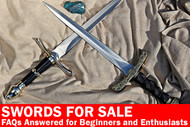Swords for Sale: FAQs Answered for Beginners and Enthusiasts
Posted by Swordsswords on Sep 22nd 2023
Are you a budding enthusiast, looking at swords for sale to start your collection?
Or a seasoned aficionado in pursuit of the next prized blade?
Whatever the scenario, this blog is your gateway to the world of swords.
We're here to provide clarity on the questions that often surround these remarkable weapons.
Let's delve into the fascinating realm of swords and arm you with the information about which swords to buy, find the perfect blade, and nurture your passion for these timeless symbols of craftsmanship and valor.
What are the types of swords?
Swords come in a wide array types, each tailored for specific purposes and historical contexts.
●Longsword: A versatile European weapon known for its two-handed grip and balanced design.
●Katana: A revered Japanese sword featuring a distinctive curved blade, prized for its sharpness.
●Rapier Swords: A European fencing sword designed for precise thrusting, often featuring an intricate hilt.
●Scimitar Sword: A curved, slashing sword popular in Middle Eastern and North African regions.
●Saber: A one-edged, typically curved sword, often used by cavalry.
●Claymore: A large, double-edged Scottish sword known for its imposing size.
●Broadsword: A heavy, double-edged sword with a straight blade, commonly associated with medieval Europe.
Each type of sword has its own unique design and purpose, reflecting the culture and historical context from which it originates.
What is a good sword for a beginner?

For beginners, a good sword choice depends on your interests and intentions.
A practical option is a well-balanced, unsharpened practice sword, like a wooden bokken or a blunt steel training sword. These allow you to learn basic techniques safely.
If you're into historical reenactment, consider a blunt, historically accurate movie sword, anime sword or medieval sword.
For martial arts practice, a lightweight, properly balanced training sword is essential.
The type of martial art you're interested in can influence your choice, whether it's kendo, fencing, or another discipline.
Ultimately, it's crucial to prioritize safety, proper training, and a sword that aligns with your specific goals and interests as a beginner.
What to know before buying a sword?
Firstly, define your purpose. Are you seeking a sword for collection, decorative display, martial arts practice, or historical reenactment? This will guide your choice.
Secondly, familiarize yourself with local laws and regulations governing sword ownership, ensuring you're on the right side of the law.
Dive into the fascinating world of sword types, exploring materials, blade lengths, and unique designs to find the perfect fit for your needs.
Mind your budget; swords span a wide price range, so it's vital to balance your desires with your financial constraints.
Seek out reputable sellers renowned for quality and authenticity.
Lastly, ponder the long-term care and storage requirements, as proper maintenance is essential to preserving your prized blade.
How much should a decent sword cost?
Determining the price tag for a decent sword is like embarking on a journey through time and craftsmanship.
Entry-level swords, perfect for enthusiasts on a budget, usually range from around $100 to $300. These are fantastic for beginners and collectors eager to dip their toes into the world of blades.
If you're craving something more remarkable in both material and workmanship, mid-range options beckon, often priced between $300 and $1,000. Here, you'll find swords that not only look exquisite but also feel authentic in your hand.
Now, for the true connoisseur, the upper echelon awaits, where prices often soar into the thousands.

These hand-forged marvels are a testament to artisanal dedication, offering unparalleled detailing, historical precision, and the promise of a legacy to be cherished.
What are the deadliest swords?
The term "deadliest swords" conjures a vivid image of history's most fearsome blades.
Among
these, the katana stands as an icon of precision and lethality. Its exceptional
sharpness, honed through centuries of Japanese craftsmanship, enabled swift and
devastating strikes.

The Damascus steel sword, famous for its intricate patterns, was a formidable weapon due to its unmatched durability and cutting power.
The Ulfberht sword, a Viking masterpiece, was feared for its combination of strength and balance.
Meanwhile, the rapier, with its elegant design, excelled in quick, lethal thrusts.

The answer to the deadliest sword lies not just in the blade but in the skill and intent of the wielder, making each of these legendary weapons both deadly and awe-inspiring.
How to care for your sword?
Caring for your sword is an art as old as the blades themselves, ensuring their longevity and maintaining their lustrous appeal. Here's a glimpse of the timeless techniques:
1. Keep It Clean: After handling, wipe the blade with a clean cloth to remove fingerprints and moisture, preventing rust.
2.Oil the Blade: Regularly apply a light coat of sword oil to protect against corrosion and keep it gleaming.
3.Mind the Scabbard: Ensure the scabbard is clean and dry, preventing moisture buildup that can harm the blade.
4.Display with Care: Use wall mounts or stands to proudly showcase your sword, minimizing contact with abrasive surfaces.
5.Regular Inspections: Periodically check for rust, loose parts, or any signs of wear and address them promptly.
6.Respect the Blade: Handle it with reverence, avoiding unnecessary strikes or contact.
Remember, caring for your sword isn't just maintenance; it's a way of honoring the timeless craftsmanship and history it embodies.
Check out our fascinating collection of swords on sale and start your collection now!

